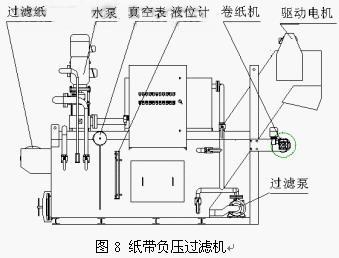Brief description of filtration and purification treatment methods for machine cutting fluids (4)
3) Negative pressure filter
Negative pressure filters are currently the most widely used form of filtration, and negative pressure filters come in many forms. The negative pressure filter mainly has several forms such as a paper negative pressure filter and a Hoffman negative pressure filter.
3.1) Paper tape negative pressure filter
Figure 8 shows the paper negative pressure filter produced by our company. The paper negative pressure filter is a large tank with a negative pressure chamber at the bottom of the tank. The upper part of the negative pressure chamber is separated from the dirty liquid tank by a stainless steel filter paper holder. After the dirty liquid enters the dirty liquid tank, the cutting fluid enters the negative pressure chamber through the filter medium, and the pump withdraws the clean liquid from the negative pressure chamber and supplies it to the machine tool. Under the suction of the pump, the negative pressure chamber will form a negative pressure to accelerate the filtration speed of the medium. When the “filter cake†formed by the accumulation of impurities on the filter paper reaches a certain thickness, the vacuum relay in the negative pressure chamber will start the sewage discharge. The squeegee drives the filter paper a distance to move the dirty paper out of the filter zone while walking into a new piece of paper and continuing to filter. The paper belt negative pressure filter has high filtration speed and high filtration precision, and has no requirement for cutting fluid.

3.2) Hoffman filter
The dirty liquid enters the upper part of the filter medium, and the filter medium uses a metal chain as a bracket, and a fan is used to suck air in the negative pressure chamber to form a negative pressure, forcing the cutting fluid to pass through the filter medium and enter the negative pressure chamber. Impurities such as oil slick on the surface of the cutting fluid can be blown to the end of the filter cake and discharged out of the filter zone along with the filter cake. When the filter cake is thickened, the resistance increases, and when the negative pressure reaches the set value, the chain drags the filter cloth out of the filter zone, and at the same time enters the new paper and continues to filter. The whole machine is automatically controlled by PLC programmable controller and has fault self-diagnosis function, which is suitable for the requirements of modern unmanned processing environment. As shown in Figure 9.

7) Centralized filtration of cutting fluid
There are two types of cutting fluid circulation: single filter and concentrated filter. Single-machine loop filtration means that each machine's filtration system is independent. The single-machine circulating filter system is generally equipped with the equipment of the bearing processing machine. It is generally simple and has low filtering precision. It can only meet the requirements of low-precision bearing production and cannot meet the needs of high-precision and low-noise bearings. This independent filtration cycle is generally suitable for working with a small number of machine tools or using different cutting fluids. For large mechanical processing plants that use wet processing, centralized filtration is recommended. The centralized filtration system is the trend of modern wet processing filtration. Compared with the single-machine circulation system, the superiority of centralized filtration is reflected in the following aspects:
1) Small footprint: Large centralized filtration system is much smaller than single-machine filtration.
2) Easy to manage: When adding cutting fluid, the number of points is small, the cutting fluid management personnel can be reduced, the waste cutting fluid can be processed centrally, and the environmental pollution is small; the discharged iron scraps are concentrated, which is convenient for transportation and processing; the use of cutting fluid can be detected centrally.
3) The filtering accuracy is easy to control;
4) Easy to implement automatic control.
Figure 10 is a schematic illustration of a typical centralized filtration system. The system consists of automatic liquid distribution system, liquid supply pipe, scraper coarse filtration, paper negative pressure filter fine filtration, aeration sterilization, oil cleaning, liquid supply pump set and electrical automatic control system.

Previous page next page
Plano-convex cylindrical lenses feature a single plano and single convex cylindrical surface, while their focal length is positive. These lenses operate only in one dimension rather than two, compared to plano-convex spherical lenses.
Plano convex cylindrical lenses are utilized to compress light in 1 axis. In order to generate a line image from a point of light and to change the aspect ratio of an image, a positive (convex) Cylindrical Lens is used. It is also applied to focus collimated input light to a line. Plano convex cylindrical lenses are normally used for line detector arrays, anamorphic beam shaping, laser projection, laser line focusing, and illumination of slit.
Plano Convex Cylindrical Lens,Meniscus Lens,Optic Lens,Cylinder Lens
Changchun Realpoo Photoelectric Co., Ltd. , https://www.optics-realpoo.com
